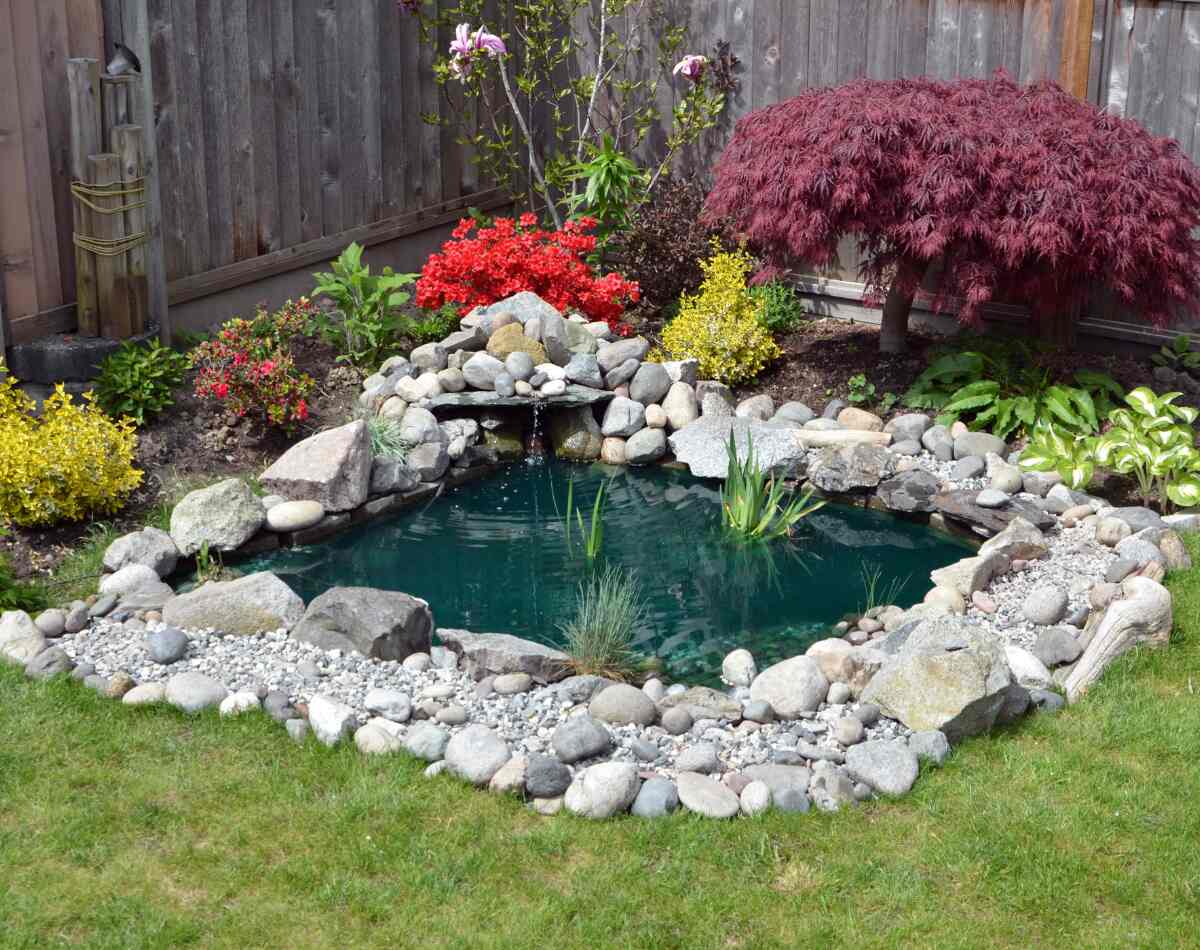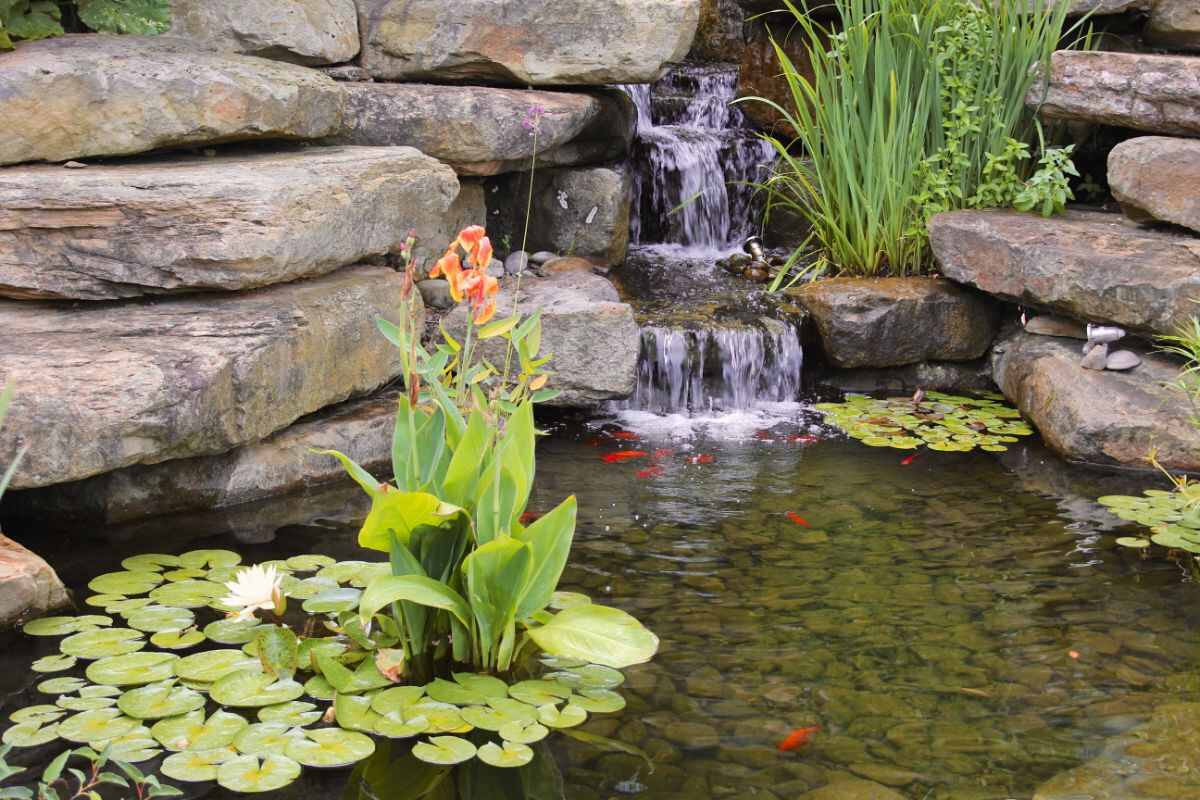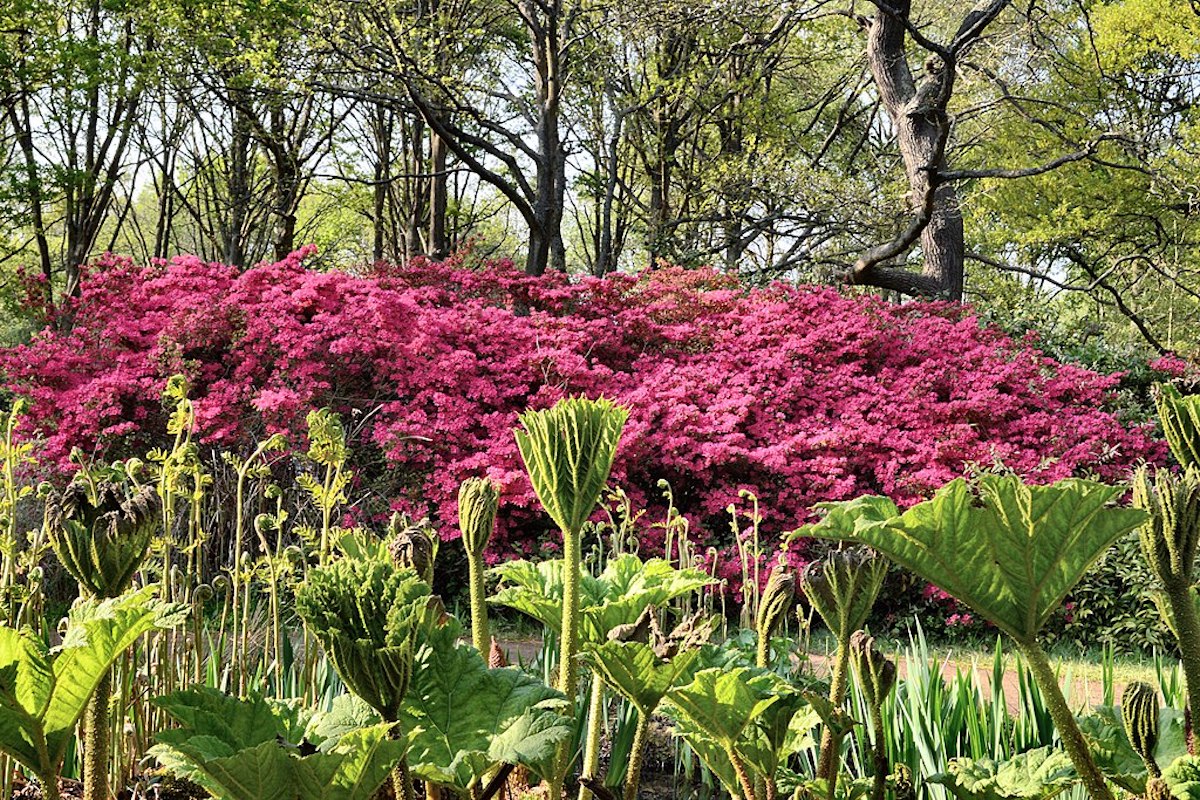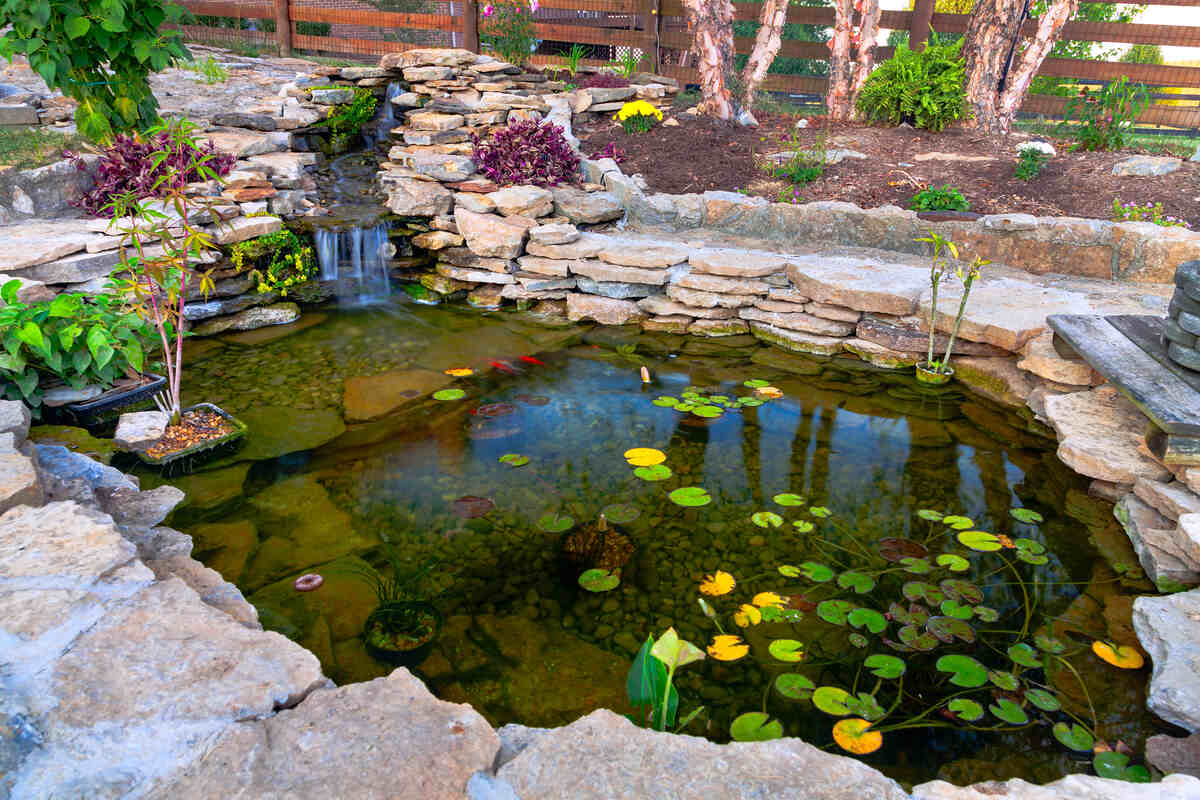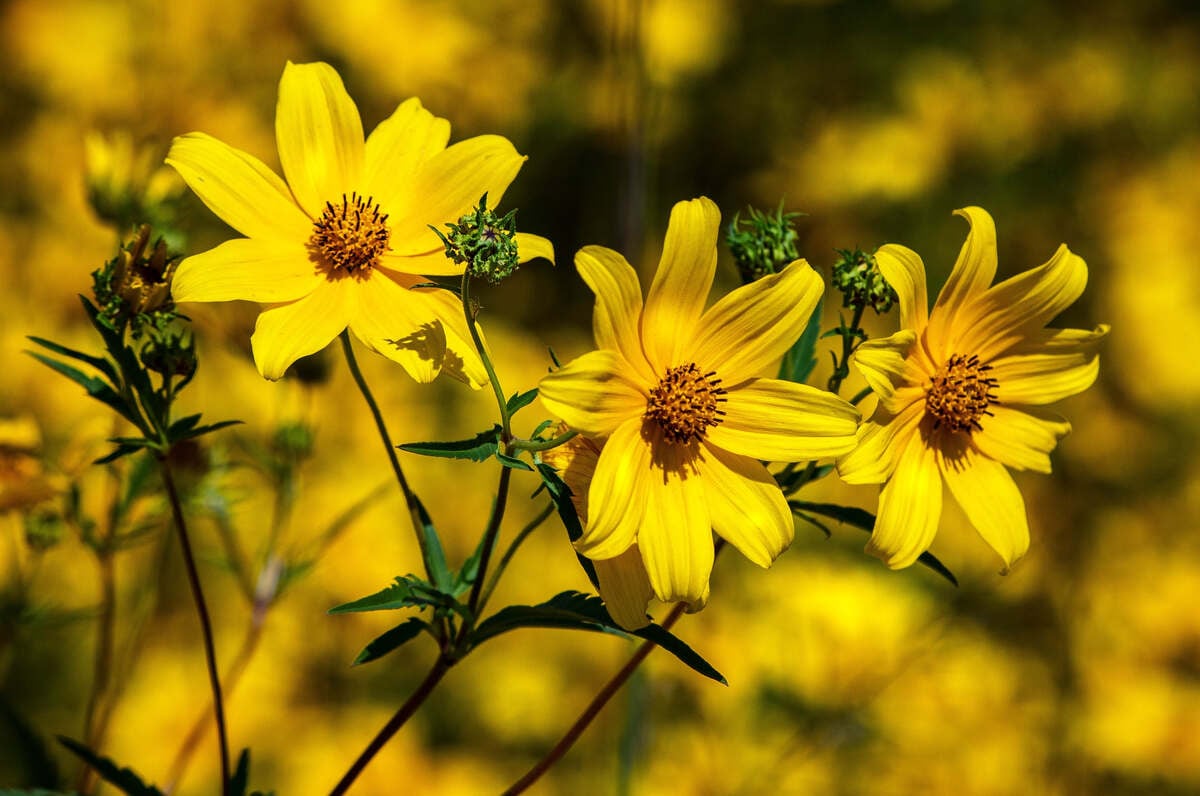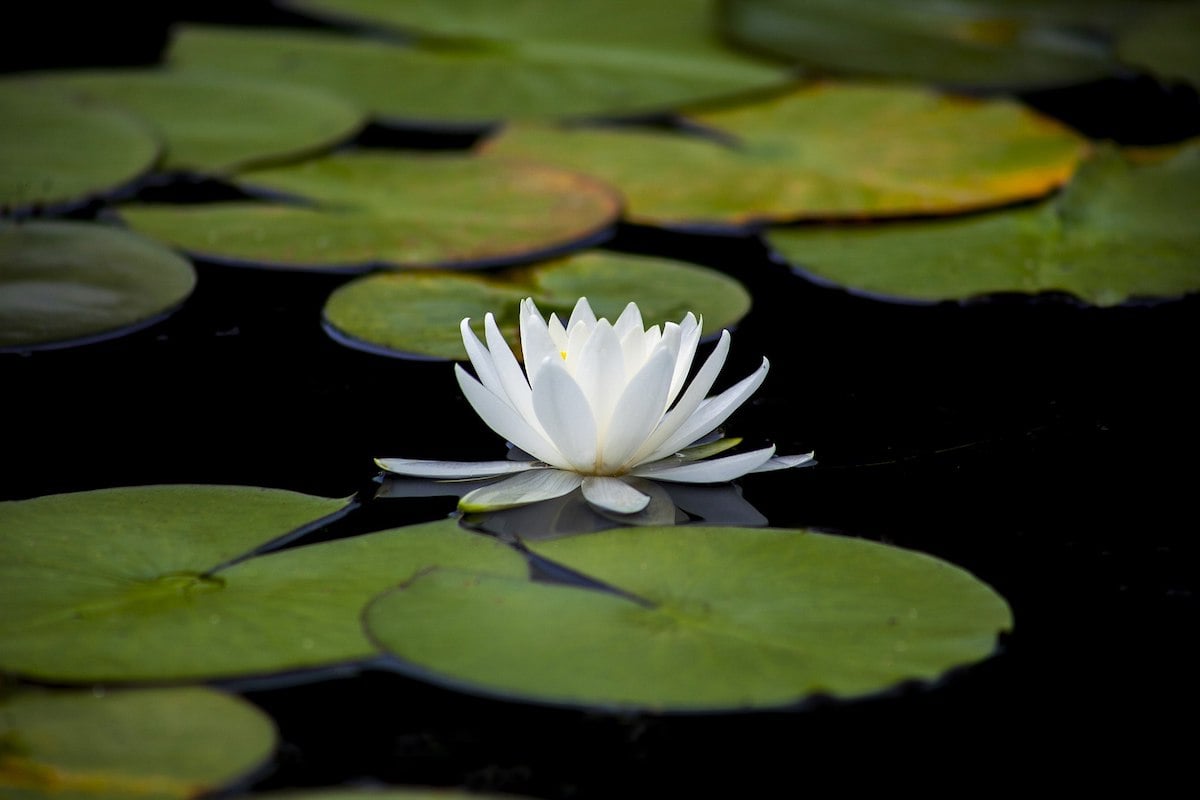
Is your landscape’s water garden looking more like a fish pond than a garden? Are your container water gardens full of water but missing, you know, the actual plants? To help get you started, we have compiled a list of 16 perfect plants to grow in your water garden (and six to avoid).
16 Plants to Grow in Your Water Garden
A water garden isn’t a water garden until there are aquatic plants to show off. Whether you want floating plants, marginal plants, or bog plants, the right greenery can turn your simple water garden into an oasis of your favorite colors, textures, and scents –– and don’t forget the lulling sounds of rippling water.
There are plenty of flowers that grow in water to choose from, but some may require more maintenance than others. While some water garden plants may be pretty, their aggressive spreading can make them a no-no for your quiet getaway. Here is our selection of plants to grow in ponds so you can create your own beautiful water garden.
1. Lotus

Turn your water garden into a showpiece with the lotus flower’s striking symmetry and colors.
It’s easy to confuse these pond plants with water lilies. Remember that the lotus flower rises well above the water, while the water lily flower floats.
USDA hardiness zone: 4-10
Scientific name: Nelumbo nucifera
Common names: Sacred lotus, Indian lotus, Egyptian bean, and bean of India.
Growing conditions: Lotus plants grow at the bottom of your water garden in submerged containers without drainage holes. The flower will bloom above the water’s surface. These plants prefer full sunlight and can handle some shade.
2. Sweet Flag

Sweet flag, a bright green monocot, adds a little texture around your water garden. Sweet flag exists in clumps, spreading via underground rhizomes. This tall water plant can create a dense ground cover over time, though it’s not considered invasive. Snip off its leaves to get whiffs of the plant’s sweet scent.
USDA hardiness zone: 6-9. Some varieties are hardy in 4-11.
Scientific name: Acorus calamus
Common names: Calamus
Growing conditions: These marginal plants grow near water and tolerate partial shade and full sun. The more sun they receive, the more water they will need. Sweet flag does not tolerate dry soil. Sweet flag thrives in consistently moist soil or standing water about 4 to 6 inches deep.
3. Cattail

Swaying cattails bring relaxation to your water garden. When cattails are ready to spread their seeds, the brown flower will pop open, revealing a mass of soft fluff. The wind then carries these fluffy seed clumps to new areas, allowing cattails to spread with ease.
USDA hardiness zone: 3-10
Scientific name: Typha latifolia
Common names: Reedmace, bulrush, reed, punks, cumbungi, and raupo.
Growing conditions: Cattails grow well in up to 12 inches of water or moist soil. Plant the cattails in pots to prevent their aggressive rhizomes from spreading. They can tolerate partial shade but prefer full sunlight.
4. Purple Pitcher Plant

Carnivorous purple pitcher plants are some of the first to install in your water garden’s boggy areas. If you’ve got a bog garden, they’ll grow well there, too. Talk about low-maintenance plants… You don’t need to feed these hungry aquatic plants — pitcher plants set their own traps.
USDA hardiness zone: 2-9
Scientific name: Sarracenia purpurea
Common names: Purple pitcher plant, turtle socks, northern pitcher plant, and side-saddle flower.
Growing conditions: Plant these bog carnivores at the edge of your water garden. These plants grow near water and flourish in moist soil that isn’t too rich or fertile. Various pitcher plants will require a specific soil mixture, most thriving in peat moss. Grow your purple pitcher plant in full sun.
5. Canna Lily

Does your water garden need a tropical twist? If yes, squeeze in some red, orange, or yellow canna lilies. Their tall, erect blooms and ornamental leaves will add a finishing touch to your water garden.
USDA hardiness zone: 8-12
Scientific genus name: Canna
Common names: Canna and canna lily
Growing conditions: Cannas like moist, boggy conditions with full sun. They tolerate well-draining, organic-rich soil that is either neutral or slightly acidic.
6. Water Lily

There are two main water lily types: hardy and tropical. Hardy water lilies will weather the winter if you plant them below the water’s freezing line. Tropical water lilies won’t survive the cold and will need to be treated as annuals or stored through the winter.
Regardless of which type you choose, hardy and tropical lilies will add color to your water garden — and the lily pads may become a resting place for frogs.
USDA hardiness zone: Hardy water lilies (4-11), Tropical water lilies (9-11)
Scientific name: Nymphaea
Common names: Water lilies and waterlilies
Growing conditions: Plant your water lilies in containers at the bottom of your water garden and watch their blooms blossom over the surface of the water. Most water lilies can withstand only depths of 6 to 18 inches, but you may need to adjust the depth depending on the variety you grow.
7. Tiger Lily

The tiger lily is native to Asia and has become a naturalized plant throughout many New England areas. It’s sought after for its showy, bright-colored blooms and unusual speckled dots. Luckily it won’t roar and scare your water garden’s fish.
USDA hardiness zone: 3-9
Scientific name: Lilium lancifolium
Common names: Tiger lily
Growing conditions: Tiger lilies crave moist, fertile soil with good drainage. They can tolerate full sun or part shade and make an excellent addition to the water garden’s edge.
8. Pickerelweed

Mix up your backyard pond with plants of various heights. Pickerelweed can reach up to 5 feet above the water’s surface. A treat for the eyes is the plant’s purple spears sprouting toward the sky.
Pickerelweed has another benefit for water gardens: It is frequently used to stabilize retention ponds and banks of natural bodies of water.
USDA hardiness zone: 3-10
Scientific name: Pontederia cordata
Common names: Pickerelweed (USA) and pickerel weed (UK)
Growing conditions: Pickerelweed develops well in shallow waters about 3 to 5 inches deep with plenty of sunshine. Plant it in containers to avoid any unwanted spreading.
9. Marsh Marigold

You value the oasis your water garden has become. Make it more relaxing with marsh marigold’s little spots of yellow sunshine.
The marsh marigold is a perennial herb in the buttercup family. The plant’s glossy green leaves can appear round, kidney-shaped, oval, or even heart-shaped. Its various leaf shapes and small clumps of yellow flowers will bring added texture to your water garden.
Note that marsh marigold can cause skin irritation and is poisonous to consume for humans and livestock.
USDA hardiness zone: 3-7
Scientific name: Caltha palustris
Common names: Kingcup, yellow marsh marigold, cowslip, and Caltha cowslip.
Growing conditions: Marsh marigolds thrive in boggy areas with moist soil and good drainage. Feature them near your pond’s edge in a spot with full sun to light shade.
10. Cardinal Flower

The cardinal plant’s brilliant red flowers will put on a show in your water garden, and the trumpet-like blooms will invite ruby-throated hummingbirds to your backyard getaway.
USDA hardiness zone: 3-9
Scientific name: Lobelia cardinalis
Common names: Red lobelia
Growing conditions: Cardinal flowers do well with morning sun and afternoon shade, except in colder regions where they need full sun. They prefer moist, fertile soil and can tolerate poor drainage.
11. Japanese Iris (Iris ensata)

Japanese irises produce ruffled, intricate blooms standing tall above their sword-like leaves. Japanese irises can grow up to 4 feet tall, with leaves reaching up to 2 feet, creating a beautiful border wall around your water garden.
USDA hardiness zone: 4-9
Scientific name: The name “Japanese iris” includes three Iris species grown in gardens or existing in the wild in Japan. These species include: hanashōbu (Iris ensata), kakitsubata (Iris laevigata) and ayame (Iris sanguinea). Hanashōbu (Iris ensata) is the one most commonly called “Japanese iris” outside Japan.
Common names: Japanese water iris
Growing conditions: Iris ensata grows best in moist, boggy areas with humus-rich soil and acidic water. The plant thrives in full sun to part shade and can live in up to 6 inches of standing water.
In winter, Japanese iris rhizomes may rot in standing water and boggy soils. It’s best to plant the flower in pots that you can later remove from the ground in fall and winter to avoid rotting.
12. Mosaic Flower

A great plant for ponds, the mosaic flower will turn your water garden into an art piece with its diamond leaves and yellow blooms.
USDA hardiness zone: 9-11
Scientific name: Ludwigia sedoides
Common names: False loosestrife
Growing conditions: Mosaic plant is intolerant of alkaline water. It prefers a pH between 5.5 and 7.5 and may die in a pH above 8. It floats on the water’s surface, growing best at your pond’s shallow edges. Grow it in full sun to part shade.
13. Swamp Lily

A splash of color can do wonders for a dull water garden, but so can the swamp lily’s white blooms (white is, after all, all the colors combined). This bulbous perennial has six delicate white petals, long purple stamens, and a sweet fragrance.
USDA hardiness zone: 7-11
Scientific name: Crinum pedunculatum
Common names: River lily, mangrove lily, and string lily
Growing conditions: Swamp lily thrives in consistently moist soil with good drainage. It requires full sun and can flourish in up to 6 inches of standing water.
14. Corkscrew Rush
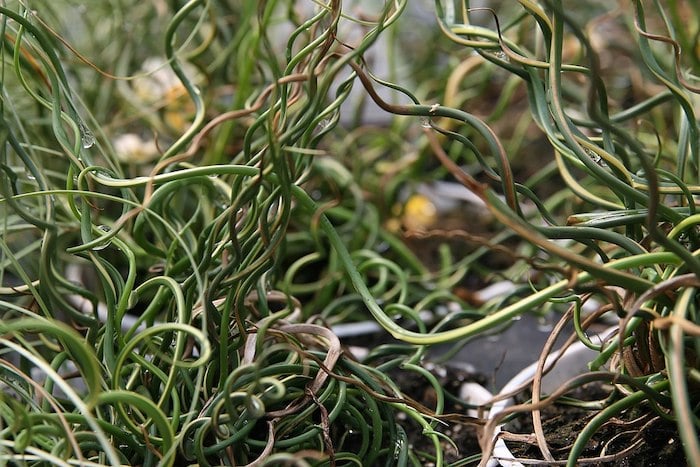
Corkscrew rush will fit right into your water garden or container garden, especially if you’re seeking an unruly, wild look. Its long blades twist and curl from the base to the blossoming foliage. For visual interest, add to your water garden corkscrew rush’s crazy twists and turns.
USDA hardiness zone: 4-9
Scientific name: Juncus effusus “Spiralis” (it is a cultivar of the soft rush, Juncus effusus).
Common names: Juncus spiralis and twisted rush
Growing conditions: Corkscrew rush grows best in full sun. In areas with extreme heat, the plant will tolerate partial shade. It prospers in boggy areas and will look great near the water’s edge.
15. Broadleaf Arrowhead

Broadleaf arrowhead is a perennial that forms dense clusters emerging up to 4 feet tall. Its arrowhead-shaped leaves feature various sizes coupled with three-petaled, white flowers.
USDA hardiness zone: 5-10
Scientific name: Sagittaria latifolia
Common names: Duck-potato, Indian potato, and wapato.
Growing conditions: Plant broadleaf arrowhead in consistently wet soil or up to 6 to 12 inches of water. This plant prefers areas with full sun.
16. Blue Flag Iris

The clump-forming blue flag iris sprouts up to 3 feet above sword-shaped leaves. Its leaves either stand erect or arch, typically reaching lengths of around 2 feet.
Note that blue flag iris can spread quickly. It’s best for water gardeners to keep this plant under control if they want their water garden to flaunt this attractive bloom while also preserving native plants.
USDA hardiness zone: 3-9
Scientific name: Iris versicolor
Common names: Northern blue flag, harlequin blueflag, larger blue flag, and poison flag.
Growing conditions: Blue flag iris favors loamy, organic-rich soil. It can survive at the water’s edge or up to 4 inches of standing water.
6 Highly Invasive Plants You May Want to Avoid
Now that we have shown you some of the best water plants for ponds to compose your water garden, let’s talk about the ones you’ll want to avoid.
1. Water Hyacinth

The water hyacinth is a curse and a gift. Its erect blooms can sprinkle the water garden with purple petals and dots of yellow. But while water hyacinth may be a lovely plant to look at, its invasive qualities make it difficult to control.
Water hyacinth quickly multiplies and can create a dense cover over your water feature. Overgrowth can limit sunlight from reaching aquatic life. As the plant dies, oxygen will deplete from the water garden. If it invades local waterways, it can pose a severe threat to biodiversity.
2. Duckweed

Duckweed can serve many benefits for an ecosystem, but its impressive growth may prove a nuisance for first-time gardeners. In other words: Duckweed may lead to more work and a lot less afternoon relaxation.
Duckweed’s advantages include: Providing a food source for fish, improving water quality, and reducing the algae photosynthesis process. But duckweed produces new offshoots at a rapid pace. The aggressive invader can quickly choke out small ponds and kill aquatic life beneath the surface.
3. Yellow Flag Iris

Yellow flag iris is an attractive plant to grow along your water garden’s edge, but this invasive ornamental perennial has become a problem in many states. It’s easy for yellow flag iris to escape garden ponds and water gardens and invade streams, wetlands, lakes, swamps, and marshes.
According to the Oregon State University Extension Service, the yellow flag iris’s clump growth can reduce water storage carrying capacity in wetlands, block irrigation canal flow, and block flood control ditches. Yellow flag iris is also challenging to eradicate once established.
All parts of this attractive plant are poisonous. Its toxicity can be a significant problem in ecosystems where the plant has reduced wildlife food sources.
4. Chameleon Plant

The chameleon plant craves your water garden’s moist soil and shallow water. While its leaves might be colorful, the chameleon plant is highly invasive and hard to kill.
Its creeping habit will allow it to take over your water garden. It may be best to cross this plant off the list and opt for a more controllable ground cover that’s just as beautiful and less of a threat to your water garden.
5. Water Lettuce

Free-floating water lettuce resembles an open head of lettuce. While some gardeners may keep water lettuce under control, its invasive properties make it illegal to sell in several states. Water lettuce is a rapid spreader, creating thick floating mats that can cause oxygen depletion and kill fish. If it escapes into waterways, it may affect essential water flow.
Water lettuce’s dense mats can cause problems for swimmers and boaters and hinder other recreational activities. These thick mats may also crush other existing aquatic plants that provide shelter and food sources to wildlife.
Keep in mind that water lettuce attracts mosquitoes. A mat of invasive water lettuce can become a breeding ground for these disease carriers.
6. European Frogbit

This aquatic plant originated from Europe and is an invasive species spreading in the U.S. and Canada. European frogbit can reduce dissolved oxygen levels, hinder recreation, limit water flow, harm fish habitats, and affect native aquatic plants’ light conditions.
European frogbit is a severe concern in Michigan. According to the Michigan State University Extension, this invasive species is spreading along the shorelines and wetlands of Lakes Huron, Erie, and Ontario.
In 1932, the plant was brought from Europe to the Central Experimental Farm in Ottawa, Canada. By 1939, the plant had escaped control and spread to the Rideau Canal.
Water Garden Plants Should Relax You, Not Stress You
Your water garden can host a number of your favorite plants. Whether you want a twisting corkscrew rush or fragrant swamp lily, it’s important to remember:
The more manageable the plants are, the more relaxing your water garden is for you.
You won’t squeeze in a calming meditation by the water garden’s trickling fountains when you’re worrying about water lettuce overtaking the pond.
FAQ
What Are Aquatic Plants?
Aquatic plants are plants that thrive in water or near water sites. Aquatic plants play an essential role in lakes and aquatic ecosystems, serving as food and shelter to different kinds of fishes and other aquatic wild animals.
When is the Best Time to Plant Aquatic Plants?
The best time to plant aquatic plants is mid-spring to early summer.
What are the Different Types of Aquatic Plants?
Different types of aquatic plants grow in different habitats:
- Floating: These aquatic plants grow on the surface of the body of water.
- Marginals: Perfect to add to a bog garden, these aquatic plants grow on the edge of ponds or lakes.
- Submerged: Submerged plants grow below the water’s surface. Some species are floating but others are rooted at the bottom of the pond.
- Deep water: These aquatics can survive with 4 to 10 inches of water over their crowns. They provide shade for fish with their floating leaves.
When to Call a Professional
It may be easy to know which plants you want for your garden, but deciding where to put them can be difficult. When you haven’t a clue about the best plant arrangement for your water garden, call a landscaping professional near you for design assistance.
A professional can help determine which textures and colors go well together and how to arrange your plants so you can see all their blooms, colors, and foliage. A landscaper also can provide water gardening maintenance and installation solutions.
Main image credit: dae jeung kim / Wikimedia Commons / CC0 1.0
